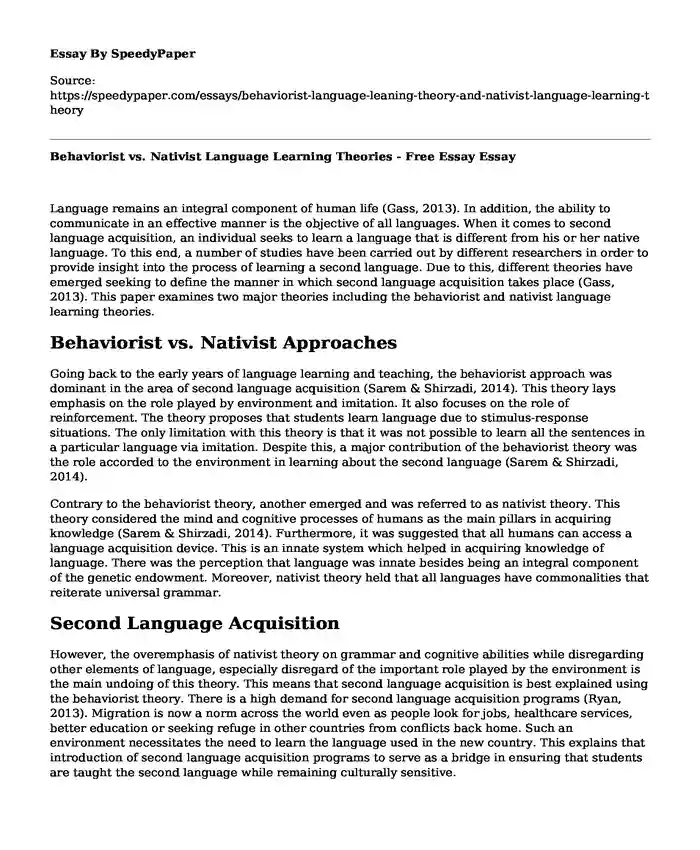
| Type of paper: | Essay |
| Categories: | Learning English 101 Languages |
| Pages: | 3 |
| Wordcount: | 604 words |
Language remains an integral component of human life (Gass, 2013). In addition, the ability to communicate in an effective manner is the objective of all languages. When it comes to second language acquisition, an individual seeks to learn a language that is different from his or her native language. To this end, a number of studies have been carried out by different researchers in order to provide insight into the process of learning a second language. Due to this, different theories have emerged seeking to define the manner in which second language acquisition takes place (Gass, 2013). This paper examines two major theories including the behaviorist and nativist language learning theories.
Behaviorist vs. Nativist Approaches
Going back to the early years of language learning and teaching, the behaviorist approach was dominant in the area of second language acquisition (Sarem & Shirzadi, 2014). This theory lays emphasis on the role played by environment and imitation. It also focuses on the role of reinforcement. The theory proposes that students learn language due to stimulus-response situations. The only limitation with this theory is that it was not possible to learn all the sentences in a particular language via imitation. Despite this, a major contribution of the behaviorist theory was the role accorded to the environment in learning about the second language (Sarem & Shirzadi, 2014).
Contrary to the behaviorist theory, another emerged and was referred to as nativist theory. This theory considered the mind and cognitive processes of humans as the main pillars in acquiring knowledge (Sarem & Shirzadi, 2014). Furthermore, it was suggested that all humans can access a language acquisition device. This is an innate system which helped in acquiring knowledge of language. There was the perception that language was innate besides being an integral component of the genetic endowment. Moreover, nativist theory held that all languages have commonalities that reiterate universal grammar.
Second Language Acquisition
However, the overemphasis of nativist theory on grammar and cognitive abilities while disregarding other elements of language, especially disregard of the important role played by the environment is the main undoing of this theory. This means that second language acquisition is best explained using the behaviorist theory. There is a high demand for second language acquisition programs (Ryan, 2013). Migration is now a norm across the world even as people look for jobs, healthcare services, better education or seeking refuge in other countries from conflicts back home. Such an environment necessitates the need to learn the language used in the new country. This explains that introduction of second language acquisition programs to serve as a bridge in ensuring that students are taught the second language while remaining culturally sensitive.
Conclusion
In a nut shell, the need to learn about a second a language has become a requirement in this world is highly globalized. A number of theories have been proposed to explain second language acquisition. However, the theory that best explains this phenomenon is the behaviorist theory. The environment in this regard has a major impact on second language acquisition. There are different factors that can make one migrate to a different country including job opportunities or the need to flee from conflicts back at home. In such situations, the new environment forces one learn the local language. This is explained by the behaviorist theory
References
Gass, S. (2013). Second Language Acquisition: An Introductory Course. Taylor & Francis, 21
Aug 2013
Ryan, C. (2013). Language use in the United States. Retrieved from:
http://www.census.gov/prod/2013pubs/acs-22.pdf
Sarem, S & Shirzadi, Y. (2014). A Critical Review of the Interactionist Approach to Second
Language Acquisition. Journal of Applied Linguistics and Language Research, Volume 1, Issue 1, 2014, pp. 62-74
Cite this page
Behaviorist vs. Nativist Language Learning Theories - Free Essay. (2019, Nov 20). Retrieved from https://speedypaper.net/essays/behaviorist-language-leaning-theory-and-nativist-language-learning-theory
Request Removal
If you are the original author of this essay and no longer wish to have it published on the SpeedyPaper website, please click below to request its removal:
- Bhagwandas Metals Limited - Free Essay on Financial Statements
- The Liberal Tantrums: A Book Review of "The Once and Future Liberal" by Mark Lilla
- Essay Sample Describing Three Arms of Government
- Paper Example on Roadblocks That Faces When Attempting to Utilize Talents
- Essay Sample. Annotated Webliography
- Essay Example. Human Resource Policy Project
- Free Essay Example - Mentalism
Popular categories




